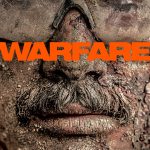Due to its inherent nature, there’s always a bit of a remove between the viewer and what they see on the screen. Since the invention of cinema, filmmakers have been attempting to bridge the gap between fiction and reality, trying to make the movie-going experience as immersive as possible. Gimmicks such as 3-D and Sensurround, as well as wide-screen formats like 70 MM and IMAX, have been employed to varying degrees of success but in the end, a gripping story and devoted cast are the most reliable tools needed to put us in the shoes of those we see on screen.
With “Warfare,” directors Alex Garland and Ray Mendoza pull this off handsomely, embedding the viewer with a group of young soldiers during a mission in 2006 during the Iraq war that went horribly sideways. Mendoza, being a part of the squad, was compelled to recreate and document this for a variety of reasons. He shared these with me during a recent conversation we had in Chicago, while Garland related how they collaborated and went about creating a sense of realism on screen that proves engrossing, and at times, terrifying.
Mendoza, who obviously still has difficulty discussing these events, said the impetus behind making the film was two-fold, the primary one being his brother-in-arms, Elliott Miller.
“Elliott Miller was a friend of mine, one of my best friends,” he related. “As you can see in the film he was severely injured during the battle. He lacks that core memory. He doesn’t recall what happened. Ultimately, the reason why we did it was for Elliott, so that he can remember all he’s gone through and how far he’s come.”
The other motivation for Mendoza was the hope that “Warfare” would be used as a catalyst to get other veterans to speak of their combat experiences. “The most common mechanism amongst people who serve in Iraq and Afghanistan is just to kind of push it down. And then it’s something you think you’re going to be able to talk about it with your friends later on. But you never do because when we come back, you never get to talk about the emotional components. One of the reasons we made the film was in the hope it would prompt other veterans to open up and speak about their experiences. Too often, they keep their feelings and pain inside but the only way to truly heal is by confronting what’s hurting you. We hope this film will help them do that.”
Mendoza brought up the idea for “Warfare” while working with Garland on his film “Civil War.” Much like that film, the director went to great lengths to make the combat experience in their new film as realistic as possible.
“There was a rule in the film, a kind of Dogme-like rule, that nothing could be invented—nothing could go into the film that wasn’t sourced from someone that was there,” Garland says. “Ray would give me extraordinary details and information about some of the guys or the things that happened on other operations, character details, but we didn’t use those because they sat outside the time frame of the film.”
“We could not change sequences of events,” he continues. “We could not do what film often does which is compress time, remove characters that are perceived as not being sufficiently dramatic, or crunch three people into one person. That’s what we couldn’t do. So, we had a super-simple goal: How do we make this as accurate as we can? And we had memory to work off.”
The result is a war film rare within the genre. Told in real time, we are introduced to these young as they put themselves in a position of support, a period that borders on tedium. However, when the shooting starts and all their plans go out the window, the film becomes a nightmare, one in which we come to appreciate all we ask those who serve to commit to and sacrifice for.
In conclusion, Garland related, “It was an amazing experience but also a humbling one. It was a great honor to be brought in by Ray, not just to his world but to his story. I and the cast and the crew wanted to make sure we honored the story Ray needed to tell. It’s important for civilians to get a sense of what war is like, so that when they say, ‘Thanks you for your service,’ they know what they service was and what it means.”
As for Elliott, I asked Mendoza how his friend is doing, “He’s doing as well as he can,” he said. “He has good days and bad and has done what he can to get back to his life.”
In the end, the experience of bringing “Warfare” to the screen helped not only him, but others in the unit as well who helped behind the scenes. “It was therapeutic and brought back friendships that were lost for 20 years. A lot healing took place because of the making of the movie. There’s a lot of filmmakers who make moves about war. They have their perspective and the lenes through which they view things. This is the veteran’s perspective. There are things we concentrate on that only a veteran would identify. Mine is not the only voice, it’s just a voice.”
“Warfare” begins in theaters, April 11th.




